
Cast *Interesting Facts *Behind-the-scenes*T.H. White's Novel *The lyrics of "Mad Madam Mim"!

Cast *Interesting Facts *Behind-the-scenes*T.H. White's Novel *The lyrics of "Mad Madam Mim"!
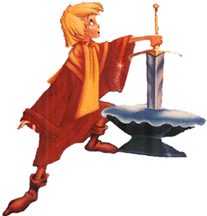 Directed
by: Wolfgang Reitherman
Directed
by: Wolfgang Reitherman
Written by: Bill Peet
Music by: George Bruns, Richard M. Sherman & Robert B.
Sherman
Released on: December 25, 1963
Running Time: 79 minutes
Box Office: $22.182 million in the U.S.
 Arthur
(Wart)... Rickie Sorenson
Arthur
(Wart)... Rickie Sorenson
Merlin the Magician... Karl Swenson
Archimedes... Junius C. Matthews
Madame Mim/Castle Scullery Maid/Granny Squirrel... Martha
Wentworth
Sir Ector/Narrator... Sebastian Cabot
Sir Kay... Norman Alden
The Scullery Maid... Barbara Jo Allen
Sir Pelinore... Alan Napier
Arthur (Wart)... Richard Reitherman & Robert Reitherman
![]()
 Junius
Matthews (1890-1978) was the voice of Rabbit in the Winnie the pooh movies
until his death.
Junius
Matthews (1890-1978) was the voice of Rabbit in the Winnie the pooh movies
until his death.
![]()
 The
wonderfully talented Martha Wentworth (1889-1974) started her Disney career
providing her voice for different characters in 1961's 101
Dalmatians: Nanny, Queenie and Lucy. Her Madame Mim character was
so successful she later appeared as a regular in Disney comic books, as
Magica de Spell's sidekick!
The
wonderfully talented Martha Wentworth (1889-1974) started her Disney career
providing her voice for different characters in 1961's 101
Dalmatians: Nanny, Queenie and Lucy. Her Madame Mim character was
so successful she later appeared as a regular in Disney comic books, as
Magica de Spell's sidekick!
![]() Sebastian
Cabot (1918-1977) was the voice of Bagheera in The Jungle Book (1967),
as well as the narrator of the Winnie the Pooh movies until his death.
Sebastian
Cabot (1918-1977) was the voice of Bagheera in The Jungle Book (1967),
as well as the narrator of the Winnie the Pooh movies until his death.
![]() Barbara
Jo Allen (1906-1994) also gave life to the green fairy Fauna in Sleeping
Beauty (1959).
Barbara
Jo Allen (1906-1994) also gave life to the green fairy Fauna in Sleeping
Beauty (1959).
INTERESTING
FACTS

![]() The Sword in the
Stone was a rare film dealing with a male character, in telling the
story of King Arthur as a young boy. The movie is somewhat
dated because it is filled with 1960s references, but it has some wonderful
moments, especially the highly imaginative wizard's duel. Unfortunately,
the hard-edged style of animation that worked so well for
101
Dalmatians (1961) were a minor fault here. The drawings were
criticized for lacking the depth, detail, and beauty that made Disney's
earliest work so captivating.
The Sword in the
Stone was a rare film dealing with a male character, in telling the
story of King Arthur as a young boy. The movie is somewhat
dated because it is filled with 1960s references, but it has some wonderful
moments, especially the highly imaginative wizard's duel. Unfortunately,
the hard-edged style of animation that worked so well for
101
Dalmatians (1961) were a minor fault here. The drawings were
criticized for lacking the depth, detail, and beauty that made Disney's
earliest work so captivating.
![]() It is based
on The Sword in the Stone (1939) by T. H. White.
Some feel the essence of the original story was lost in this adaptation,
particularly in the cooky portrayal of Merlin.
It is based
on The Sword in the Stone (1939) by T. H. White.
Some feel the essence of the original story was lost in this adaptation,
particularly in the cooky portrayal of Merlin.
![]()
 It
marked Wolfgang Reitherman's first solo directorial effort for a feature
film. His sons Richard and Robert were both cast in The Sword
in the Stone as additional voices for Wart.
It
marked Wolfgang Reitherman's first solo directorial effort for a feature
film. His sons Richard and Robert were both cast in The Sword
in the Stone as additional voices for Wart.
![]() Storyman Bill
Peet recalled in the late '90s that "there was some criticism that we treated
[The Once and Future King] too lightly. But if we had gotten too
heavily into it, it would have been a real drag. We decided to make it
playful because almost everyone knows the story. There had already been
too many Knights of the Round Table epics and that was not for us.
While I chose to do Sword in the Stone, a group of about six people
- Marc Davis, Ken Anderson, Woolie Reitherman, Milt Kahl, etc. - spent
about six months developing a manuscript for Chanticleer, a psychological
drama by Edmund Rostand, the author of Cyrano de Bergerac. There
was a meeting and Milt Kahl said, 'I can draw a goddamned good rooster!'
I said, 'Well so can I, but that's not the problem. The story doesn't come
off for me because its just a little too weird.' They all got pretty angry
with me. I continued working alone on my script for Sword in the Stone
and they started work on Chanticleer. Months went by
and I finally got it together and on the boards. Meanwhile, Frank [Thomas],
Ollie [Johnston], Woolie Reitherman and all the others were having meetings
at night developing a manuscript, plus elaborately illustrated storyboards,
large color pastel paintings and had songwriters in to write songs and
record music. Finally Walt called a meeting to see what they
had done on Chanticleer. They showed it all to Walt. Ken Anderson
asked what he thought and he said, 'Just one word - shit!' Then he said,
'Let's go see what Bill Peet is working on.' Here come all of these people
into my studio. They were all sulking and hoping I'd fall on my face. They
hadn't spoken to me the entire time. I went through the storyboards
and showed some of the gags with Merlin and the Owl. I showed Merlin packing
everything into one suitcase, which was my own, it wasn't in the book.
When I was done, Walt asked them what they thought - pretty good, huh?
And they said, 'Oh yeah!!' You can imagine how humiliated they were to
accept defeat and give in to Sword in the Stone. The cost
with all those salaries? Too much! No wonder Walt was pissed off. He allowed
them to have their own way, and they let him down. They never understood
that I wasn't trying to compete with them, just trying to do what I wanted
to work. I was in the midst of all this competition, and with Walt to please
too. "
Storyman Bill
Peet recalled in the late '90s that "there was some criticism that we treated
[The Once and Future King] too lightly. But if we had gotten too
heavily into it, it would have been a real drag. We decided to make it
playful because almost everyone knows the story. There had already been
too many Knights of the Round Table epics and that was not for us.
While I chose to do Sword in the Stone, a group of about six people
- Marc Davis, Ken Anderson, Woolie Reitherman, Milt Kahl, etc. - spent
about six months developing a manuscript for Chanticleer, a psychological
drama by Edmund Rostand, the author of Cyrano de Bergerac. There
was a meeting and Milt Kahl said, 'I can draw a goddamned good rooster!'
I said, 'Well so can I, but that's not the problem. The story doesn't come
off for me because its just a little too weird.' They all got pretty angry
with me. I continued working alone on my script for Sword in the Stone
and they started work on Chanticleer. Months went by
and I finally got it together and on the boards. Meanwhile, Frank [Thomas],
Ollie [Johnston], Woolie Reitherman and all the others were having meetings
at night developing a manuscript, plus elaborately illustrated storyboards,
large color pastel paintings and had songwriters in to write songs and
record music. Finally Walt called a meeting to see what they
had done on Chanticleer. They showed it all to Walt. Ken Anderson
asked what he thought and he said, 'Just one word - shit!' Then he said,
'Let's go see what Bill Peet is working on.' Here come all of these people
into my studio. They were all sulking and hoping I'd fall on my face. They
hadn't spoken to me the entire time. I went through the storyboards
and showed some of the gags with Merlin and the Owl. I showed Merlin packing
everything into one suitcase, which was my own, it wasn't in the book.
When I was done, Walt asked them what they thought - pretty good, huh?
And they said, 'Oh yeah!!' You can imagine how humiliated they were to
accept defeat and give in to Sword in the Stone. The cost
with all those salaries? Too much! No wonder Walt was pissed off. He allowed
them to have their own way, and they let him down. They never understood
that I wasn't trying to compete with them, just trying to do what I wanted
to work. I was in the midst of all this competition, and with Walt to please
too. "
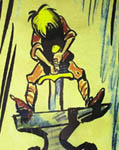
![]() Bill Peet
continues reminscing that he "gave [Merlin] Walt's nose and character.
A little playful, but sometimes not. He's cantankerous, argumentative.
He can't be wrong. I'm the Owl [laughs], or maybe more like Wart. Milt
Kahl balked at drawing my Merlin. He took all the illustrated King Arthur
books out of the library to check out the Merlins - always tall, austere
figures with long black beards and star-spangled robes. But Walt
liked my Merlin, not knowing of course that it was my version of him. Even
after Sword in the Stone finally began to move into animation, Woolie Reitherman,
the director, continued to resist and warned me, 'We'll never finish this
picture,' which I considered a peculiar remark at that stage of the game.
However, he was quite content to take credit for it once it was completed.
I wrote the lyrics to the song during the wizard's duel. When I designed
'Madam Mim,' who was this frowzy old lady, Walt said, 'Bill, why can't
we have a big, tall dame with black hair?' I said, 'Walt, we always do
that. She has to be a counterpart to Merlin. He's an old eccentric, and
so she has to be too. They have to match.'"
Bill Peet
continues reminscing that he "gave [Merlin] Walt's nose and character.
A little playful, but sometimes not. He's cantankerous, argumentative.
He can't be wrong. I'm the Owl [laughs], or maybe more like Wart. Milt
Kahl balked at drawing my Merlin. He took all the illustrated King Arthur
books out of the library to check out the Merlins - always tall, austere
figures with long black beards and star-spangled robes. But Walt
liked my Merlin, not knowing of course that it was my version of him. Even
after Sword in the Stone finally began to move into animation, Woolie Reitherman,
the director, continued to resist and warned me, 'We'll never finish this
picture,' which I considered a peculiar remark at that stage of the game.
However, he was quite content to take credit for it once it was completed.
I wrote the lyrics to the song during the wizard's duel. When I designed
'Madam Mim,' who was this frowzy old lady, Walt said, 'Bill, why can't
we have a big, tall dame with black hair?' I said, 'Walt, we always do
that. She has to be a counterpart to Merlin. He's an old eccentric, and
so she has to be too. They have to match.'"
![]() This film is
Disney’s only full-length animated feature to have had a Christmas Day
release.
This film is
Disney’s only full-length animated feature to have had a Christmas Day
release.
![]() The Sword
in the Stone ranked fifth on the list of top grossing films at the
boxoffice for 1963, grossing $10,475,000 in its initial release.
The Sword
in the Stone ranked fifth on the list of top grossing films at the
boxoffice for 1963, grossing $10,475,000 in its initial release.
T.H. White was born in Bombay, India, in 1906. In 19828, White graduated from Queen's College, Cambridge, and began to write. By the mid-1930s, he had published several books, including poetry under his own name and novels under the pseudonym James Aston.
Astonished at the depth and the humanity of the chracters in Malory's Morte d'Arthur, While was inspired to write his own interpretation of the legend of King Arthur. The first volume, The Sword In The Stone, appeared in 1938. It was followed by The Witch In The Wood (later called The Queen Of Air And Darkness0 in 1939, and The Ill-Made Knight in 1940. The books are philosophically concerned with right and might, and they express White's conviction that people are basically goodm but do not know how to direct their power toward positive ends.
Veteran storyman Bill Peet brought the 1938 novel to Walt Disney's attention. The books's philosophies, combined with vividly described characters, the animation potential of sorcery, and an appealing boy hero can be assumed to be the key appeal of the story to Walt Disney. Walt was enamored of the Arthurian legend, and had been enchanted by the musical Camelot on Broadway in 1960 (the young leading lady, Julie Andrews, was to be Walt's own Mary Poppins in her Hollywood film debut).
Walt assigned Peet to write a screenplay, something that was then rare in the development of an animated feature, where the story was usually developed on storyboards. Peet complied, and Walt approved The Sword In The Stone for production.
Peet admits that his often-contentious relationship with Walt Disney informed the character of Merlin in the film. "In his book, T.H. White describes the wizard as a crusty old curmudgeon, argumentative and temperamental, playful at times, and extremely intelligent," Peet wrote in his autobiography. "Walt was not quite a curmudgeon and he had no beard, but he was a grandfather and much more of a character, and in my drawings of Merlin I even borrowed Walt's nose."
The songwriting Sherman brothers had only recently been signed to a Disney contract when they were approached to add songs to The Sword In The Stone. "We always start not from the board and not from the film, but from an idea: what's this all about? And then when we have a conception, we discuss who's gonna sing it, what words it's gonna say twice, in what personnality the words will come... All these ingredients we discuss long before any melody [gets written]! And then we start saying, 'What's a good angle, what's a new angle?' Very often we try to come up with something a little different, that's why we invent words sometimes, like Higitus Figitus. For this song, we wanted some British sounding magic", that would be the equivalent of Abracadabra. "So we started declining some latin!'
"That was our first animated features, and we didn't really know how pictures were made. We wrote several songs for The Sword In The Stone that never made it to the final version. One of them was called The Blue Oak Tree which was meant to be sung by the Knights, to show how stupid they were. All they would do all day is drink and fight and drink some more. We had fun with that one!"
One other song that we really liked is The Magic Key. They wanted to move the story forward to Merlin and Wart to go back to that castle. This has more meaning that Higitus Figitus." And indeed it is a great song! "I haven't played that song in 37 years since it was tossed out of the movie!" Sword In The Stone was really a wonderful experience for us and it certainly made our future success with Disney movies like Poppins, Jungle Book and the Winnie the Pooh series, and The Tigger Movie!
The Sword In The Stone took 3 years to produce. It was the
first solo directorial effort by one of Walt Disney's fabled "Nine Old
Men", Wolfgang "Woolie" Reitherman (1909-1985), who had been an animator
at Diseny since 1933, and had co-directed Sleeping
Beauty. After Walt's death, Reitherman supervised the production
and direction of all of the animated features until his retirement in 1980.
T.H. WHITE'S NOVEL, THE SWORD IN THE STONE
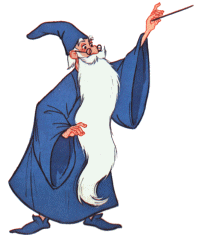 The
Sword in the Stone is an example of Arthurian Legend. The Arthurian
Legend was developed in the Middle Ages regarding Arthur, the semi-historical
king of the Britons, and his order of knights. The legend is a complex
weaving of ancient Celtic mythology with later traditions, around a core
of possible authenticity. T.H. White's The Sword in the Stone
deals with Arthur’s childhood and his life shortly after becoming king.
Throughout this childhood, he learns the theories of chivalry, which involve
the graduations of page, squire, and finally knighthood.
The
Sword in the Stone is an example of Arthurian Legend. The Arthurian
Legend was developed in the Middle Ages regarding Arthur, the semi-historical
king of the Britons, and his order of knights. The legend is a complex
weaving of ancient Celtic mythology with later traditions, around a core
of possible authenticity. T.H. White's The Sword in the Stone
deals with Arthur’s childhood and his life shortly after becoming king.
Throughout this childhood, he learns the theories of chivalry, which involve
the graduations of page, squire, and finally knighthood.
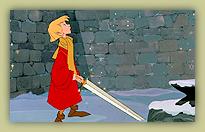 As
an innovation to the Arthurian Legend, T. H. White incorporated fables
throughout the story, which make it more humorous and enjoyable.
Magician and tutor Merlyn puts much of his energy into teaching Arthur
through experiences, by magically transforming him into an ant, a fish,
a bird, and a badger. He also sends Arthur and Kay on a dangerous and exciting
adventure, in which they meet Robin Wood, Marian, and Little John, to name
a few.
As
an innovation to the Arthurian Legend, T. H. White incorporated fables
throughout the story, which make it more humorous and enjoyable.
Magician and tutor Merlyn puts much of his energy into teaching Arthur
through experiences, by magically transforming him into an ant, a fish,
a bird, and a badger. He also sends Arthur and Kay on a dangerous and exciting
adventure, in which they meet Robin Wood, Marian, and Little John, to name
a few.
White's Merlin is rather comic, often getting spells jumbled, and
his power arises from having lived his life backwards -a nice touch that
lets T.H. White insert modern perspective into an ancient story without
narratorial intrusions. The harsh criticisms of socialism in the
ants segment are particularly darkly drawn.
"The best thing for being sad is to learn something. That is the only thing that never fails. You may grow old and trembling in your anatomies, you may lie awake at night listening to the disorder of your veins, you may miss your only love, you may see the world about you devastated by evil lunatics, or know your honour trampled in the sewers of baser minds. There is only one thing for it then -to learn."
Merlyn in "The Once and Future King"
This wise teaching was loosely -but very smartly- adapted in
Disney's animated feature, in a monologue where Merlin explains to Wart
that once you hit rock bottom, you cannot go any downer and the only way
is up.
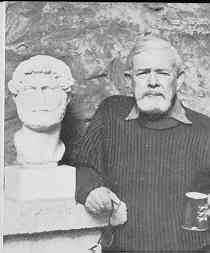 The
Sword in the Stone was only the first of four novels by T.H. White
retelling the Arthurian legend, from Arthur's birth to the end of his reign.
This quartet was published in a single volume called Once Upon a King
in 1958: it comprises The Sword in the Stone (1938), The Queen
of Air and Darkness -first published as The Witch in the Wood
(1939)-, The Ill-Made Knight (1940), and The Candle in the Wind
(published in the composite volume, 1958). They were all based largely
on Sir Thomas Malory's Le Morte Darthur. After White's death in
1964, a conclusion to The Once and Future King was found among his
papers; it was published in 1977 as The Book of Merlyn.
The
Sword in the Stone was only the first of four novels by T.H. White
retelling the Arthurian legend, from Arthur's birth to the end of his reign.
This quartet was published in a single volume called Once Upon a King
in 1958: it comprises The Sword in the Stone (1938), The Queen
of Air and Darkness -first published as The Witch in the Wood
(1939)-, The Ill-Made Knight (1940), and The Candle in the Wind
(published in the composite volume, 1958). They were all based largely
on Sir Thomas Malory's Le Morte Darthur. After White's death in
1964, a conclusion to The Once and Future King was found among his
papers; it was published in 1977 as The Book of Merlyn.
THE LYRICS OF "MAD MADAM MIM"!
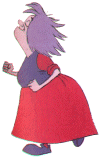 Written
by: Richard Sherman & Robert Sherman
Written
by: Richard Sherman & Robert Sherman
Performed by: Martha Wentworth [Madam Mim]
With only a touch
I have the power
Zim zaba rim bim
To wither a flower
I find delight in the gruesome and grim
'Cause I'm the magnificent, marvelous, mad Madam Mim
I can be huge
Fill a whole house
I can be tiny,
Small as a mouse
Black sorcery is my dish of tea
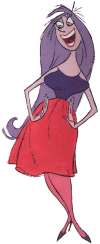 It
comes easy to me
It
comes easy to me
'Cause I'm the magnificent, marvelous,
Mad Madam Mim!
I can be beautiful, lovely and fair
Silvery voice, long purple hair
La la la la la, la la la la la
La la la la la
But it's only skin deep
For zim zaberim zim
I'm an ugly old creep
Magnificent, marvelous, mad, mad, mad, mad Madam Mim!
|
||||||||||||